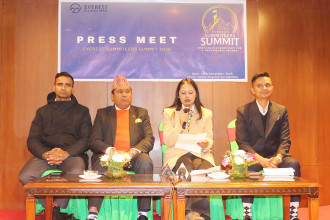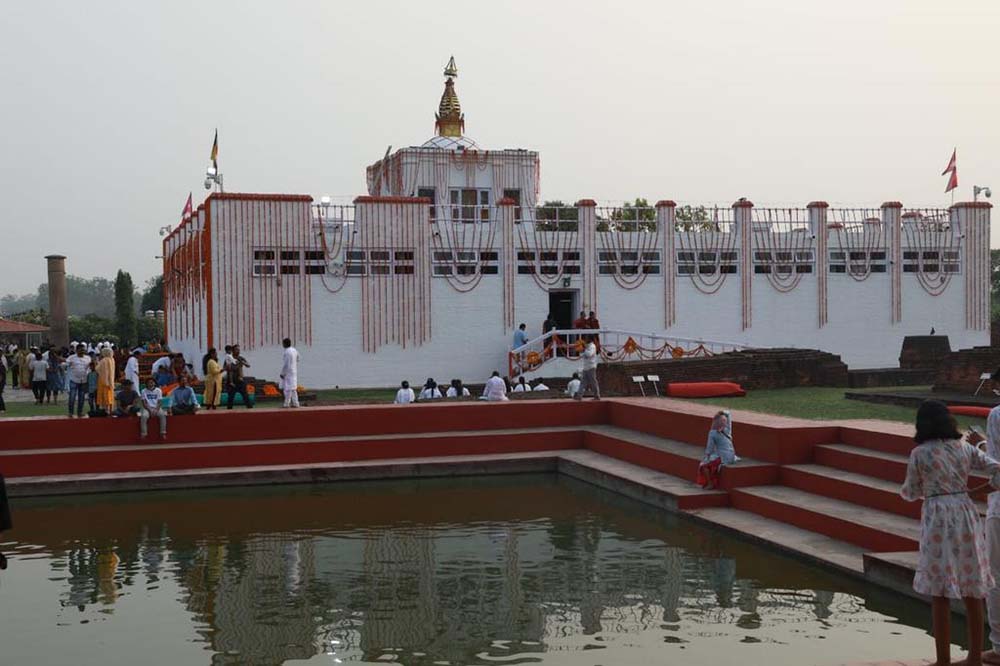
RUPANDEHI: The master plan for the development of birthplace of the Buddha is in the completion phase. This master plan prepared by the famous Japanese architect Prof Kenzo Tange (1913 -2005) will conclude nearly 40 years after it was first implemented. It took six years for Tange to draw up the Lumbini Master Plan.
Although the goal was to implement it within 15 years in two phases, the works as per the master plan are not complete even now due to the negligence of the government. It is almost certain that Lumbini will be one of the few places worth visiting once the master plan is implemented fully albeit late.
According to Basanta Maharjan, a researcher in Buddhism, Lumbini being developed as an international tourism site and the operation of the Gautam Buddha International Airport about 20 kilometres (km) away indicates a bright future for this area.
"Had the Lumbini Master Plan been executed within the specified time, tourism in the area would have increased by leaps and bounds. But although late, it is in completion phase, and this development is good," Maharjan, a writer, said. He suggested linking the Buddhist sites of Nepal and India and promoting tourism in Lumbini for reaping economic benefits.
Although hundreds of thousands of Buddhist tourists on Lumbini visit use the itinerary of touring this holy place of Buddhism as per the Buddhist culture, they stay here only for three days. As per the itinerary suggested by the master plan, on the first day, the pilgrims spend the night in Lumbini village area, and mentally and physically prepare the spiritual zone. On the second day, they purify their mind in the cultural zone and it's only on the third day that they have to visit the Mayadevi temple for paying homage.
The visitors are then expected to look for spending more time after three days visiting the Lumbini area which is spread on 1,155 bighas land. It is for this reason that the Lumbini development Trust (LDT), the body responsible for the development of Lumbini area, has come up with the idea of simultaneously developing the sites related to the life of the Buddha that lie in nearby Kapilvastu and Nawalparasi (Bardaghat Susta East and West).
Culture expert Dr Gitu Giri sees the need of developing these sites in Kapilvastu and Nawalparasi as well at par with Lumbini for making their pilgrimage a complete one and lengthening the stay of visitors.
"The LDT is confined only to Lumbini and due to this the other sites related to the life of the Buddha are in the shadow. Unless these sites are linked to Lumbini and developed simultaneously with it, Lumbini's tourism will not be promoted," she opined. Dr Giri stresses the need for developing these sites by conserving and promoting them if the living standard of the local people is to be improved through the promotion of tourism in Lumbini.
The government should work with commitment and the civil society as well as the private sector should join hands to achieve this goal, she suggested.
Experts on tourism and culture have suggested Nepal can reap the economic benefits from tourism in Lumbini only if other places like Tilaurakot, Gotihawa, Niglihawa, Kudan, Sagarhawa, Araurakot, Devdaha and Ramgram related to the life of the Buddha are connected to Lumbini and developed in equal footing.
Lumbini Lumbini is the place where Siddhartha Gautam was born. It is a sacred, historic, archaeologically significant and religious heritage site enlisted in the list of UNESCO World Heritage Sites. Several Buddhist literatures have indicated that queen Mayadevi, wife of king Sudhdhodan, gave birth to Siddhartha Gautam in Lumbini, a forested area, in 623 BC. In time, this forested area saw different human activities. A stone pillar installed by the Maurya dynasty emperor Ashoka in 249 BC refers to Lumbini as 'Lummini Gam'. This word is also mentioned in various texts of the Buddhist scripture the 'Tripitaka' — a collection of teachings and sermons given by Lord Buddha, composed of three main categories of texts that collectively constitute the Buddhist canon: Sutra Piṭaka, Vinaya Piṭaka and Abhidhamma Piṭaka. There are more than 24 Viharas and monasteries in Lumbini area at present. Lumbini was enlisted as World Heritage Site in 1997. There are ancient articles and relics dating back to 1100 century BC. The Mayadevi Temple is the centre of Lumbini. The followers of Buddhism wish to visit the birthplace of the Buddha once in their lifetime. Around 1.6 million visitors from around the world visit Lumbini annually.
Tilaurakot [caption id="attachment_23449" align="alignnone" width="1000"]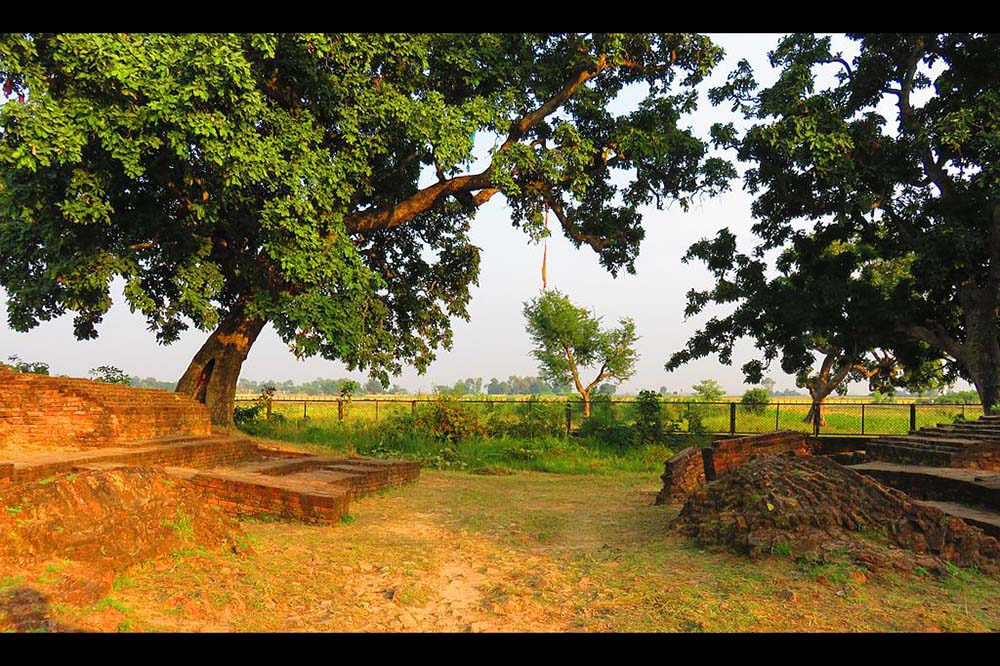 The east gate of King Suddhodana's Palace at Tilaurakot archaeological site in Taulihawa, Kapilvastu District, in November 2014. Photo courtesy: DiverDave[/caption]
Tilaurakot is another place related to the life of the Buddha. Tilaurakot, where Siddhartha Gautam spent 29 years of his life, lies about 28km west of Lumbini . Preparations are on to include Tilaurakot on the list of World Heritage Sites. LDT is organising the 'Tilaurakot Summit' on May 17 and 18 for that purpose. Experts from Nepal and various countries will be participating in this conference.
The Department of Archaeology had, with the support of the Durham University of the UK, the federal government and archaeologists, carried out archaeological excavations in Tilaurakot from time to time with the objective of collecting the required evidence for enlisting the place in the World Heritage Sites list, officiating senior archaeology officer at the Department, Himal Uprety, said. According to him, the required evidence have been collected.
Even though an important place, most visitors coming to Lumbini are not found visiting this holy place. There are no adequate tourist infrastructures here. There is the remnant of the Tilaurakot palace here. Visitors to Tilaurakot return after observing the western and eastern gates to the ancient town and the remnants of the palace which is in the centre. There is the Dhamanihawa Stupa about 700m away from the ancient palace. This is the mausoleum of King Sudhdhodan and Mayadevi, Siddhartha Gautam's parents.
The east gate of King Suddhodana's Palace at Tilaurakot archaeological site in Taulihawa, Kapilvastu District, in November 2014. Photo courtesy: DiverDave[/caption]
Tilaurakot is another place related to the life of the Buddha. Tilaurakot, where Siddhartha Gautam spent 29 years of his life, lies about 28km west of Lumbini . Preparations are on to include Tilaurakot on the list of World Heritage Sites. LDT is organising the 'Tilaurakot Summit' on May 17 and 18 for that purpose. Experts from Nepal and various countries will be participating in this conference.
The Department of Archaeology had, with the support of the Durham University of the UK, the federal government and archaeologists, carried out archaeological excavations in Tilaurakot from time to time with the objective of collecting the required evidence for enlisting the place in the World Heritage Sites list, officiating senior archaeology officer at the Department, Himal Uprety, said. According to him, the required evidence have been collected.
Even though an important place, most visitors coming to Lumbini are not found visiting this holy place. There are no adequate tourist infrastructures here. There is the remnant of the Tilaurakot palace here. Visitors to Tilaurakot return after observing the western and eastern gates to the ancient town and the remnants of the palace which is in the centre. There is the Dhamanihawa Stupa about 700m away from the ancient palace. This is the mausoleum of King Sudhdhodan and Mayadevi, Siddhartha Gautam's parents.
Gotihawa [caption id="attachment_23450" align="alignnone" width="1000"]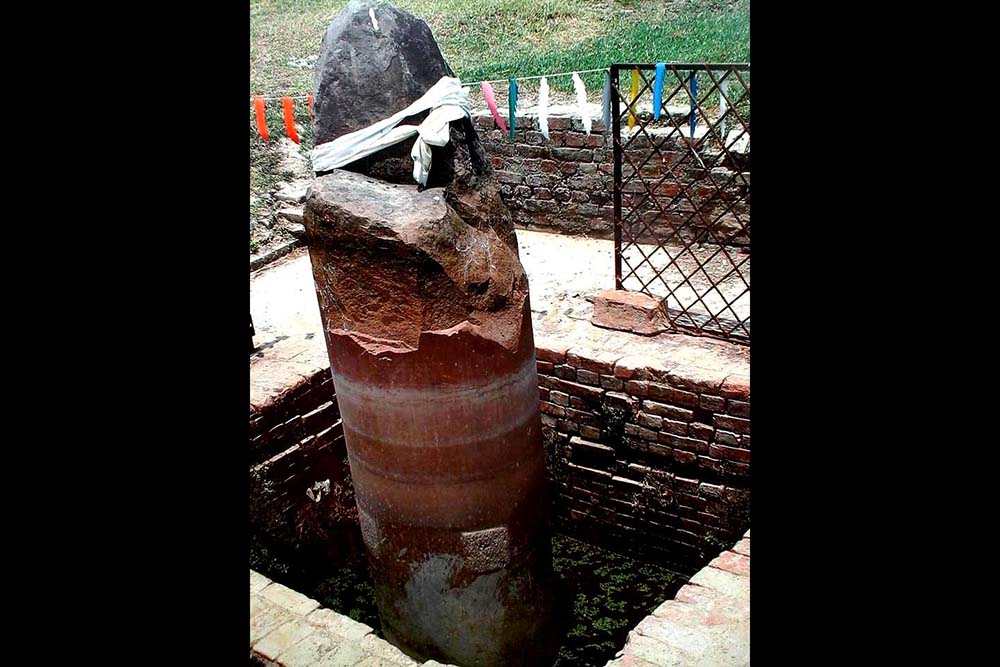 A view of Ashoka Pillar in Gotihawa. Photo courtesy: Ravi Jung[/caption]
At a distance of seven kilometres from Tilaurakot lies Gotihawa. It is the birthplace of the Krakuchhanda Buddha, one of the Buddhas among the several Buddhas. The Krakuchhanda Buddha was also born in Nepal. There are the remnants of the broken Ashoka pillar and an ancient stupa here. The Lumbini provincial government has installed a statue of the Krakuchhanda Buddha at this site.
A view of Ashoka Pillar in Gotihawa. Photo courtesy: Ravi Jung[/caption]
At a distance of seven kilometres from Tilaurakot lies Gotihawa. It is the birthplace of the Krakuchhanda Buddha, one of the Buddhas among the several Buddhas. The Krakuchhanda Buddha was also born in Nepal. There are the remnants of the broken Ashoka pillar and an ancient stupa here. The Lumbini provincial government has installed a statue of the Krakuchhanda Buddha at this site.
Niglihawa [caption id="attachment_23451" align="alignnone" width="1000"]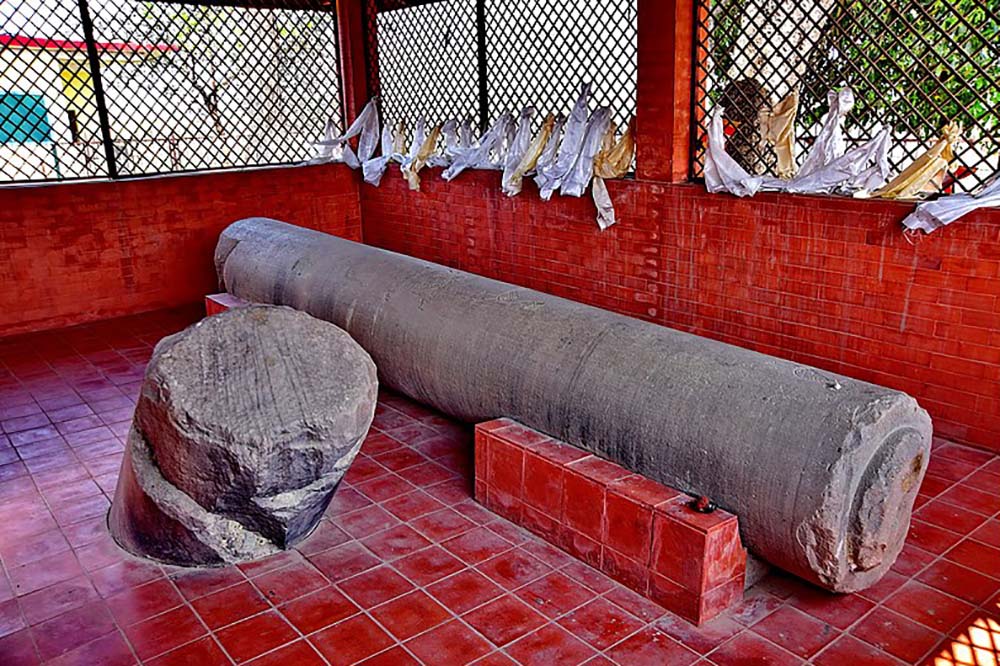 A view of Ashoka pillar built in 249 BC at Niglihawa, the birthplace of the Kanakmuni Buddha, about eight kilometres northeast of Taulihawa Bazaar in Kapilvastu district in March 2021. Photo courtesy: Rajesh Dhungana[/caption]
Niglihawa is the birthplace of Kanakmuni, another Buddha born in Nepal. It is nine kilometres away from Tilaurakot. The remnants of the broken Ashoka pillar can be seen at this site. There is also the Niglisagar pond, an ancient pond at Niglihawa. The home town of the Kanakmuni Buddha, Araurakot, is nearby. There are ancient remains at Araurakot.
A view of Ashoka pillar built in 249 BC at Niglihawa, the birthplace of the Kanakmuni Buddha, about eight kilometres northeast of Taulihawa Bazaar in Kapilvastu district in March 2021. Photo courtesy: Rajesh Dhungana[/caption]
Niglihawa is the birthplace of Kanakmuni, another Buddha born in Nepal. It is nine kilometres away from Tilaurakot. The remnants of the broken Ashoka pillar can be seen at this site. There is also the Niglisagar pond, an ancient pond at Niglihawa. The home town of the Kanakmuni Buddha, Araurakot, is nearby. There are ancient remains at Araurakot.
Sagarhawa Sagarhawa is another ancient place which is at a distance of eight kilometres from Tilaurakot. This is the place where thousands of Shakyas were killed. There are some ruins of the ancient palaces and structures and a pond at Sagarhawa at present. Dr A Fuhrer conducted an archaeological excavation at this place in 1897 and unearthed Buddha-era antiques and the remains of a stupa temple.
Nigrodharam Nigrodharam is an important place where Siddhartha Gautam met his father Sudhdhidan and stepmother Prajapati Gautami, his wife Yashodhara and son Rahul, when he was returning to the capital of the ancient kingdom Kapilvastu after attaining enlightenment. This place lies 28km to the southwest of Lumbini and it is at a distance of six kilometres from Tilaurakot. There are three stupas, one pond and a well here which are of archaeological importance.
Devdaha Devdaha lies 57km northeast of Lumbini. It is the ancient kingdom of the Buddha's maternal uncle. Devdaha is the home of Mayadevi, Prajapati and Yashodhara's parents. This place is related to the Buddha's childhood.
Ramgram Ramgram is another important place where the Buddha's relics are kept. It is located in Nawalparasi district. This ancient historical and religious place is three kilometres south of Parasi, the district headquarters. The relic of the Buddha is ensconced at the Ramgram Stupa which is 80 feet wide, 90 feet long and 30 feet tall. LDT and the Ramgram Municipality have conducted a geological survey of the ancient Ramgram area and prepared a master plan for its development. The area covered by the master plan is 117 bighas. LDT says that works on collecting the required evidence are on with the purpose of having this place also enlisted in the list of World Heritage Sites. Lumbini is in limelight as the birthplace of the Buddha, but many Buddhists and visitors are unknown of these other places which are related in one way or the other to the life of Buddha. Although archaeologically important, the LDT has not made a plan for the integrated development and promotion of these places. LDT member-secretary Sanuraja Shakya says that works will be moved ahead for the planned development of all these seven Buddhist sites in the coming days. By RSS READ ALSO:
Lumbini Lumbini is the place where Siddhartha Gautam was born. It is a sacred, historic, archaeologically significant and religious heritage site enlisted in the list of UNESCO World Heritage Sites. Several Buddhist literatures have indicated that queen Mayadevi, wife of king Sudhdhodan, gave birth to Siddhartha Gautam in Lumbini, a forested area, in 623 BC. In time, this forested area saw different human activities. A stone pillar installed by the Maurya dynasty emperor Ashoka in 249 BC refers to Lumbini as 'Lummini Gam'. This word is also mentioned in various texts of the Buddhist scripture the 'Tripitaka' — a collection of teachings and sermons given by Lord Buddha, composed of three main categories of texts that collectively constitute the Buddhist canon: Sutra Piṭaka, Vinaya Piṭaka and Abhidhamma Piṭaka. There are more than 24 Viharas and monasteries in Lumbini area at present. Lumbini was enlisted as World Heritage Site in 1997. There are ancient articles and relics dating back to 1100 century BC. The Mayadevi Temple is the centre of Lumbini. The followers of Buddhism wish to visit the birthplace of the Buddha once in their lifetime. Around 1.6 million visitors from around the world visit Lumbini annually.
Tilaurakot [caption id="attachment_23449" align="alignnone" width="1000"]
 The east gate of King Suddhodana's Palace at Tilaurakot archaeological site in Taulihawa, Kapilvastu District, in November 2014. Photo courtesy: DiverDave[/caption]
Tilaurakot is another place related to the life of the Buddha. Tilaurakot, where Siddhartha Gautam spent 29 years of his life, lies about 28km west of Lumbini . Preparations are on to include Tilaurakot on the list of World Heritage Sites. LDT is organising the 'Tilaurakot Summit' on May 17 and 18 for that purpose. Experts from Nepal and various countries will be participating in this conference.
The Department of Archaeology had, with the support of the Durham University of the UK, the federal government and archaeologists, carried out archaeological excavations in Tilaurakot from time to time with the objective of collecting the required evidence for enlisting the place in the World Heritage Sites list, officiating senior archaeology officer at the Department, Himal Uprety, said. According to him, the required evidence have been collected.
Even though an important place, most visitors coming to Lumbini are not found visiting this holy place. There are no adequate tourist infrastructures here. There is the remnant of the Tilaurakot palace here. Visitors to Tilaurakot return after observing the western and eastern gates to the ancient town and the remnants of the palace which is in the centre. There is the Dhamanihawa Stupa about 700m away from the ancient palace. This is the mausoleum of King Sudhdhodan and Mayadevi, Siddhartha Gautam's parents.
The east gate of King Suddhodana's Palace at Tilaurakot archaeological site in Taulihawa, Kapilvastu District, in November 2014. Photo courtesy: DiverDave[/caption]
Tilaurakot is another place related to the life of the Buddha. Tilaurakot, where Siddhartha Gautam spent 29 years of his life, lies about 28km west of Lumbini . Preparations are on to include Tilaurakot on the list of World Heritage Sites. LDT is organising the 'Tilaurakot Summit' on May 17 and 18 for that purpose. Experts from Nepal and various countries will be participating in this conference.
The Department of Archaeology had, with the support of the Durham University of the UK, the federal government and archaeologists, carried out archaeological excavations in Tilaurakot from time to time with the objective of collecting the required evidence for enlisting the place in the World Heritage Sites list, officiating senior archaeology officer at the Department, Himal Uprety, said. According to him, the required evidence have been collected.
Even though an important place, most visitors coming to Lumbini are not found visiting this holy place. There are no adequate tourist infrastructures here. There is the remnant of the Tilaurakot palace here. Visitors to Tilaurakot return after observing the western and eastern gates to the ancient town and the remnants of the palace which is in the centre. There is the Dhamanihawa Stupa about 700m away from the ancient palace. This is the mausoleum of King Sudhdhodan and Mayadevi, Siddhartha Gautam's parents.
Gotihawa [caption id="attachment_23450" align="alignnone" width="1000"]
 A view of Ashoka Pillar in Gotihawa. Photo courtesy: Ravi Jung[/caption]
At a distance of seven kilometres from Tilaurakot lies Gotihawa. It is the birthplace of the Krakuchhanda Buddha, one of the Buddhas among the several Buddhas. The Krakuchhanda Buddha was also born in Nepal. There are the remnants of the broken Ashoka pillar and an ancient stupa here. The Lumbini provincial government has installed a statue of the Krakuchhanda Buddha at this site.
A view of Ashoka Pillar in Gotihawa. Photo courtesy: Ravi Jung[/caption]
At a distance of seven kilometres from Tilaurakot lies Gotihawa. It is the birthplace of the Krakuchhanda Buddha, one of the Buddhas among the several Buddhas. The Krakuchhanda Buddha was also born in Nepal. There are the remnants of the broken Ashoka pillar and an ancient stupa here. The Lumbini provincial government has installed a statue of the Krakuchhanda Buddha at this site.
Niglihawa [caption id="attachment_23451" align="alignnone" width="1000"]
 A view of Ashoka pillar built in 249 BC at Niglihawa, the birthplace of the Kanakmuni Buddha, about eight kilometres northeast of Taulihawa Bazaar in Kapilvastu district in March 2021. Photo courtesy: Rajesh Dhungana[/caption]
Niglihawa is the birthplace of Kanakmuni, another Buddha born in Nepal. It is nine kilometres away from Tilaurakot. The remnants of the broken Ashoka pillar can be seen at this site. There is also the Niglisagar pond, an ancient pond at Niglihawa. The home town of the Kanakmuni Buddha, Araurakot, is nearby. There are ancient remains at Araurakot.
A view of Ashoka pillar built in 249 BC at Niglihawa, the birthplace of the Kanakmuni Buddha, about eight kilometres northeast of Taulihawa Bazaar in Kapilvastu district in March 2021. Photo courtesy: Rajesh Dhungana[/caption]
Niglihawa is the birthplace of Kanakmuni, another Buddha born in Nepal. It is nine kilometres away from Tilaurakot. The remnants of the broken Ashoka pillar can be seen at this site. There is also the Niglisagar pond, an ancient pond at Niglihawa. The home town of the Kanakmuni Buddha, Araurakot, is nearby. There are ancient remains at Araurakot.
Sagarhawa Sagarhawa is another ancient place which is at a distance of eight kilometres from Tilaurakot. This is the place where thousands of Shakyas were killed. There are some ruins of the ancient palaces and structures and a pond at Sagarhawa at present. Dr A Fuhrer conducted an archaeological excavation at this place in 1897 and unearthed Buddha-era antiques and the remains of a stupa temple.
Nigrodharam Nigrodharam is an important place where Siddhartha Gautam met his father Sudhdhidan and stepmother Prajapati Gautami, his wife Yashodhara and son Rahul, when he was returning to the capital of the ancient kingdom Kapilvastu after attaining enlightenment. This place lies 28km to the southwest of Lumbini and it is at a distance of six kilometres from Tilaurakot. There are three stupas, one pond and a well here which are of archaeological importance.
Devdaha Devdaha lies 57km northeast of Lumbini. It is the ancient kingdom of the Buddha's maternal uncle. Devdaha is the home of Mayadevi, Prajapati and Yashodhara's parents. This place is related to the Buddha's childhood.
Ramgram Ramgram is another important place where the Buddha's relics are kept. It is located in Nawalparasi district. This ancient historical and religious place is three kilometres south of Parasi, the district headquarters. The relic of the Buddha is ensconced at the Ramgram Stupa which is 80 feet wide, 90 feet long and 30 feet tall. LDT and the Ramgram Municipality have conducted a geological survey of the ancient Ramgram area and prepared a master plan for its development. The area covered by the master plan is 117 bighas. LDT says that works on collecting the required evidence are on with the purpose of having this place also enlisted in the list of World Heritage Sites. Lumbini is in limelight as the birthplace of the Buddha, but many Buddhists and visitors are unknown of these other places which are related in one way or the other to the life of Buddha. Although archaeologically important, the LDT has not made a plan for the integrated development and promotion of these places. LDT member-secretary Sanuraja Shakya says that works will be moved ahead for the planned development of all these seven Buddhist sites in the coming days. By RSS READ ALSO:
Published Date: May 16, 2022, 12:00 am
Post Comment
E-Magazine
RELATED B360 National


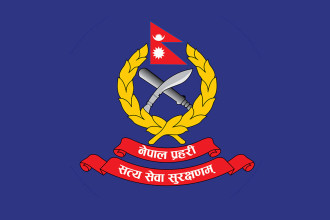
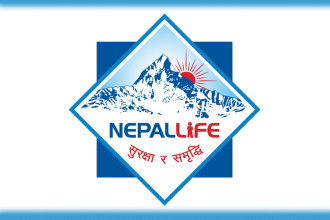
-1766986771.jpeg)
